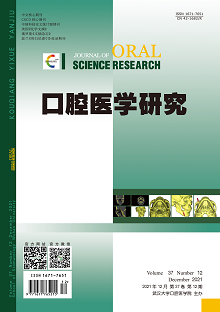|
|
Significance of Laminin, Integrin α6β1, and Focal Adhesion Kinase in Parotid Atrophy Induced by Main Duct Ligation in Rats
YU Chenglong, YANG Yong, XUE Boyuan, LI Jianwei, GAO Hong, SONG Jiaojiao, LIU Guoqi, ZUO Jinhua
2021, 37(12):
1119-1124.
DOI: 10.13701/j.cnki.kqyxyj.2021.12.013
Objective: To study the expression of laminin, integrin α6β1, and focal adhesion kinase in parotid gland atrophy process in rats, and to explore the signaling mechanism of parotid gland atrophy. Methods: A ligation model of left parotid duct was established in 54 rats, and fresh parotid tissue was obtained at 0 (control group), 1, 3, 5, 7, 10, 14, 21, and 30 days after ligation (n=6). The histological changes of parotid gland were observed using hematoxylin eosin staining (HE), and the localization and expression of laminin, integrin α6β1, and focal adhesion kinase were detected by immunohistochemistry and quantitative real-time PCR. Results: Parotid gland gradually atrophied after duct ligation. The expression of laminin and integrin α6β1 decreased during the first 3 days after duct ligation, and reached the lowest value on the day 3 (P<0.05), and the integrity of distribution of laminin and integrin α6β1 in the base of acinar cells was damaged; then the expression of laminin and integrin α6β1 gradually raised and reached the peak on the 14th day, and then decreases (P<0.05). The focal adhesion kinase decreases continuously during parotid atrophy (P<0.05). Conclusion: Laminin/integrin α6β1/focal adhesion kinase may act as a signaling pathway during parotid gland atrophy, which can respond to mechanical stimulation generated by duct ligation and transmit mechanical signals into cells, and participate in regulating the parotid atrophy process.
References |
Related Articles |
Metrics
|

